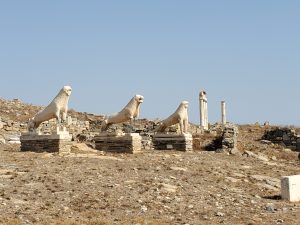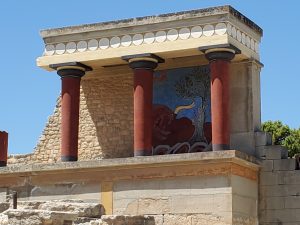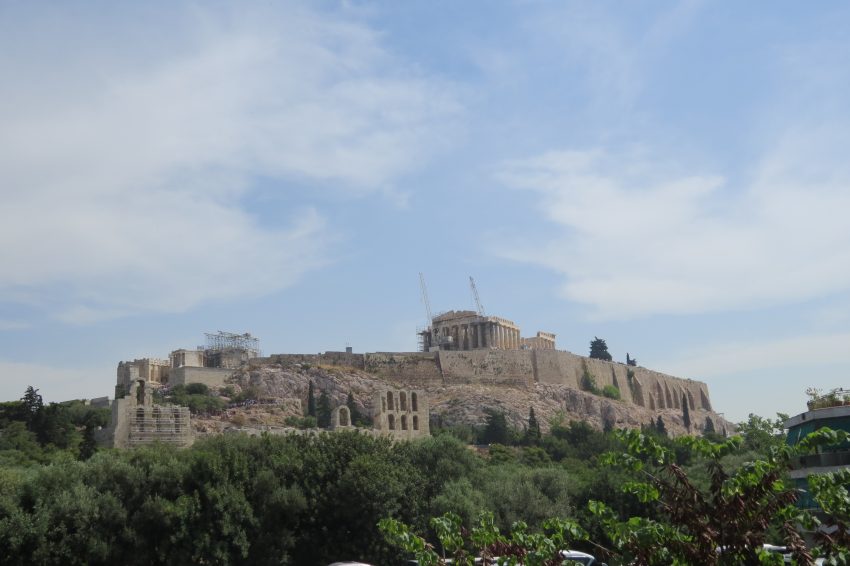Greece is always top of my list for any Mediterranean itinerary. From the whitewashed buildings with blue dome roofs down to the azure waters of the Aegean Sea, Greece is a glorious destination at any time of the year. But unlike most tourists, you will not find us on the beach. We are more likely to be climbing uneven treacherous stairs, wandering down cobblestone streets and tucking into the tiny rooms found at dusty and hot archaeological sites. Greece has the best of them.
Although we have not seen all of them – that might be unreasonable to expect we could – we do have our favourites. I am not including in this list the most iconic of all, the Acropolis in Athens. Most tourists, if they haven’t been there in person, have at least seen it in pictures and on videos. Originally built for the goddess Athena, the Parthenon has towered proudly over the capital city for centuries. It is not to be missed.
If you visit any of the smaller islands or certain parts of the mainland, be sure to check out these other great archaeological sites. Learning some Greek mythology before you go can’t hurt either.

- Delos on Mykonos
Delos, said to be the birthplace of twins Apollo and Artemis, is one of the most important mythological, historical, and archaeological sites due to its influence on the development of Greek architecture, and its sacred importance throughout Ancient Greece. The excavations in the island are among the most extensive in the Mediterranean. Featuring rows of homes, a large amphitheatre and plenty of temple remains means there is much to see. Perhaps the best known feature is the Terrace of the Lions, a monumental avenue comparable to an Egyptian avenues of sphinxes. Only about seven of the original remain today. Many of the treasures uncovered can viewed at the Athens Archaeological Museum.

- Olympia at Katakalon
This site was a major Panhellenic religious sanctuary of ancient Greece, where the ancient Olympic Games were held every four years throughout Classical antiquity, from the 8th century BC to the 4th century AD. The archaeological site held over 760 significant buildings, and ruins of many of these survive. Of special interest is the stadium. It is basically a field with start and end lines marked off by curbing. The athletes entered under an archway of a vaulted corridor, which visitors can still do today. The length of this field became the standard stadion, an ancient Greek unit of distance. Stadiums today used in the modern Olympics are created with very little change from the ancient topography. There is a museum on the site that can be explored to see some of the relics found there.

- The Acropolis at Lindos in Rhodes
The Lindos Acropolis, which stands tall at 116 meters above sea level, is a dominant feature of the area. The sanctuary is approached by a rough flight of steps, so be prepared for a workout. The acropolis is best know because of its rich history, dating back to the 10th century BC, and its stunning views of the surrounding coastline. The most prominent structure within the Acropolis, the Temple of Athena Lindia, was initially built in the 6th century BC. At the foot of the steps before you make the uphill climb, you will see a beautiful carving into the rock of an ancient vessel with 3 banks of oars.

- Akrotiri in Santorini
The Akrotiri excavation site is of a Cycladic cultural settlement on the Greek island of Santorini, associated with the Minoan civilization. Spite the fact that Akrotiri was buried by the massive Theran eruption in the middle of the second millennium it is remarkably well-preserved. Excavations began in 1967. Frescoes, pottery, furniture, advanced drainage systems and three-story buildings have been discovered at the site, but no gold valuables or human remains which means that the residents had time to escape. Artifacts from this excavation can be found in the Archeological Museum of Thera in Fira, the capital of Santorini.

- Knossos in Heraklion
Knossos is a Bronze Age archaeological site in Crete first excavated in 1877. The site was a major center of the Minoan civilization and is known for its association with the Greek myth of Theseus and the Minotaur. In Greek mythology, King Minos dwelt in a palace at Knossos. He had Daedalus construct a labyrinth, a very large maze in which to retain his son, the Minotaur, who was born with the head and tail of a bull and the body of a man.
The site is dominated by the monumental Palace of Minos which served as a combination religious and administrative center rather than a royal residence. Arthur Evans continued the excavation in 1900 and is credited with discovering the Minoan Civilization. However, he is said to have reconstructed many of the buildings using some creative input which may have altered the view we have today.

I’ve made a note of the Rhodes and Santorini recommendations as we will be there in October 🤞🏻